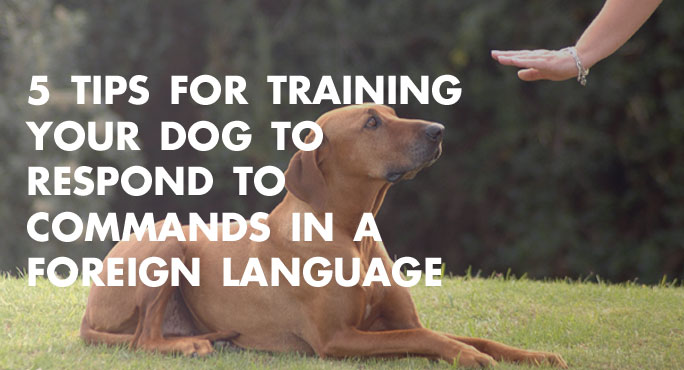5 Tips to Have Your Dog Respond To Commands In A Foreign Language
Updated on: April 19, 2022 | Author: Starwood Pet Travel

Although it may seem that your super-smart pooch hangs on your every word and understands what you say, the truth is that dogs do not understand complex language. What they do understand is word association. The sound you make when you say “sit” or “walk” to your dog comes to mean something to him, if you practice associating that sound with a specific action.
That means you can teach your pup to “speak” in any number of foreign languages – French, German, Spanish, Italian, Japanese, etc. It’s not hard to teach new commands to most dogs, but it does take time and patience. These 5 tips will help:
1. Follow a specific training procedure
If your dog already knows English commands, you can teach him to “translate” his English command into a new language by following this process. Let’s say you want to teach your dog “down” in French:
- Say the new command (couche – pronounced koosh), then immediately say “down.” Your dog doesn’t understand couche – yet – but he knows down, so he should comply. As soon as he does, praise him and reward him with a treat.
- Repeat this couche/down/praise sequence several times. Practice in different locations, so your dog associates lying down with the new word, not a specific spot.
- Now transition to French only. Simply say couche, and wait to see if your dog responds. If so, lavish him with raise and a tasty reward. Repeat this process several times, too.
This process assumes your pup is fluent (as in obedient) in English commands. If you’re starting from scratch with training, you can omit the translation aspect of the above procedure – say it, praise your dog (if he follows the command), repeat.
2. Be consistent with the word you use
Like English, foreign languages often have more than one way to say something. For instance, in French, you might tell your dog viens (come) or ici (here) if you want him to come to you. Pick one word and stick with it, so your dog doesn’t get confused.
3. Be consistent with training
Keep practicing with your dog, following the process outlined above. Just because your smarty-paws pup picked up on the new word quickly doesn’t mean he will remember it without further practice. You’ve probably forgotten most of that French you learned in school, haven’t you? “Use it or lose it” applies to your dog, too.
4. Go big with praise
Rewarding your dog with love (and a yummy treat) is always the best training technique. Never punish him or say “no” or “bad dog” if he doesn’t follow the new command. Just keep working on it until he does the right thing, then make a big deal about it. He wants to please you, so he will try his best.
5. Make it fun
Set aside a few minutes each day for “lesson time,” but practice the new language commands with your dog at other times, too. Around the house. On a walk. That way he will associate the words with specific actions but also see them as an additional connection to you. You are his pack leader, in any language.
Non-verbal commands are the universal language
Many dogs are born deaf. Out of necessity, hand signals replace words as the language of choice for training. But there are advantages to adding these commands to any pup’s multi-lingual capabilities. You and your pooch can travel the world, safe in the knowledge that communication will always be easy. Besides, it’s fun. Read here to learn more about sign training for dogs.
Did you know that dogs understand other gestures you make, too? They recognize actions such as yawning, because it’s something they do themselves.
More than a new vocabulary
If you’re moving to a foreign country, your dog may have to learn many new things beyond a few new words. Reading up on how you can help him adjust after your move will help him take his new surroundings in stride. With fewer doggie worries on his mind, he may even remember all those foreign language commands you so patiently taught him.
Take heart in knowing that your dog has used the same techniques to train you in his language. When he stands outside the front door and lets out a “Woof,” do you not rush to open the door and let him in? Of course you do. Good boy!
Subscribe to the Blog
Enjoy our content? Get them sent to your inbox!
Subscribe Now!

